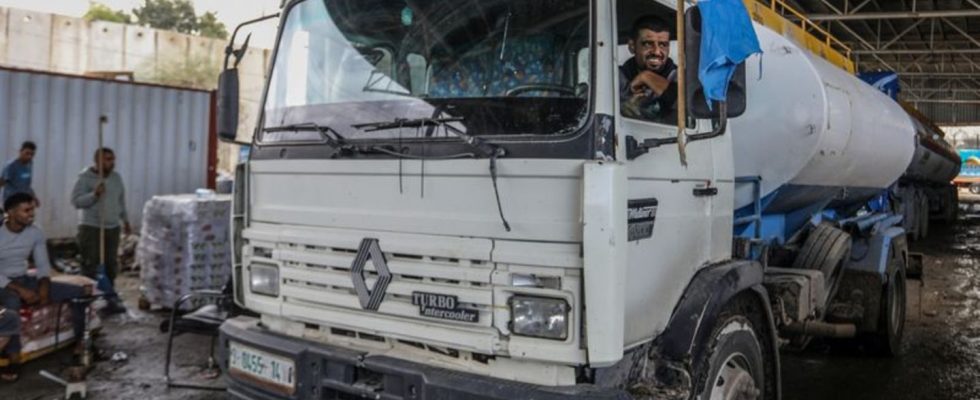A lack of fuel, especially for trucks and electricity generation, is hindering basic supplies for the civilian population in the Gaza Strip. The overview.
In the struggle for urgently needed fuel supplies for Gaza, Israel has at least partially given in to the demands of UN aid workers.
In the future, two tankers per day will be allowed to bring diesel to the coastal strip, as a high-ranking Israeli government representative said. The Relief and Works Agency for Palestine Refugees (UNWRA) had previously warned that humanitarian support for the people in the sealed off area would collapse due to a lack of fuel.
The communication networks, which had already collapsed on Thursday evening and whose power supply also depends on fuel for generators, remained disrupted. Palestinian media in the West Bank reported significant problems reaching residents of the coastal strip: calls did not go through, nor did messages.
There was initially confusion about the delivery of further relief supplies. According to Israel, 144 trucks were approved to travel from Egypt to the Gaza Strip on Thursday. UN organizations initially reported that not a single truck had arrived in the Gaza Strip that day. The UN emergency relief office specified on Friday that no trucks had arrived by 6 p.m. on Thursday.
The Israeli army again called on people in residential areas in the northern Gaza Strip to seek safety in the south. Israel’s chief of general staff announced that the operation would be expanded to other areas. Soldiers had previously discovered the dead bodies of two hostages near the Shifa hospital, which has been embattled in recent days.
Diesel is intended for water and water infrastructure
According to the information, the two daily trucks with diesel are supposed to travel from Egypt to Gaza via the Rafah border crossing. The diesel should therefore guarantee the power supply for the water and wastewater infrastructure – also to prevent the outbreak of epidemics.
UNRWA was no longer able to accept aid supplies due to a lack of fuel
Before the war, according to UN figures, around 45 tankers drove into the coastal area every day for commercial and humanitarian purposes. A UNRWA spokeswoman said the agency had been unable to accept aid supplies in recent days due to a lack of fuel in its vehicle fleet.
What caused confusion was that Israel announced that it had authorized 144 trucks to travel from Egypt to the Gaza Strip. However, according to UNRWA at midday, no help was received. It is possible that the trucks were able to enter the transit area of the border crossing and were therefore in the no man’s land between Egypt and the Gaza Strip.
UN Emergency Relief Office: Warning of danger from communications blackout
The West Bank-based telecommunications company Paltel reported the collapse of its networks in Gaza on Thursday evening. The UN emergency relief agency OCHA said this morning: “Humanitarian organizations and emergency services have warned that blackouts threaten the safety of civilians and the provision of life-saving support.”
Since the beginning of the Gaza war, communications networks in the coastal area have failed several times. Connections to the outside world were only possible with satellite cell phones and sometimes from tall buildings in the south of the Gaza Strip with Israeli SIM cards.
Two dead hostages found near Shifa Clinic
The bodies of two Israeli hostages had previously been recovered near the Shifa Hospital in Gaza, which has been embattled in recent days. They were two women aged 65 and 19. During their operation in the largest clinic on the coastal strip, the Israeli armed forces said they also found command and control centers. It remained unclear whether this was also the Hamas command center suspected to be under the hospital. Hamas denies the existence of such a base beneath the clinic.
Israeli military chief: systematically eliminate Hamas commanders
Israel’s Chief of General Staff Herzi Halevi announced an expansion of operations in the Gaza Strip. “We are close to dismantling the military system in the northern Gaza Strip (…) we will continue in other areas,” said Halevi, according to the statement, during a visit to troops in the Gaza Strip. Commanders of the Islamist Hamas must be “systematically” eliminated and infrastructure destroyed. To this end, “more and more regions are being targeted”.
So far, Israel’s ground troops have concentrated on the northern part of the Gaza Strip in recent weeks. Today the Israeli army also called on residents of several neighborhoods to seek safety in the south of the Gaza Strip. However, experts assume that operations will also be expanded in the south. There are already repeated air raids there.
Palestinians: About 800,000 people still in the north of the Gaza Strip
Almost six weeks after the start of the war, around 800,000 people are still believed to be in the northern part of the Gaza Strip. This was reported by the UN emergency relief office OCHA, citing the Palestinian Statistics Authority (PCBS) in the West Bank. It remained unclear which survey this estimate was based on.
According to the UN, a total of around 1.6 of the 2.3 million people in the Gaza Strip are on the run because of Israeli attacks. Thousands of homes have been destroyed.
Fighting again on the Lebanese-Israeli border
There was renewed fighting on the border between Israel and Lebanon. The Israeli military reported attacking several “Hezbollah terrorist targets.” The pro-Iranian Hezbollah said it attacked Israeli targets with “appropriate weapons” and scored “direct hits.”

